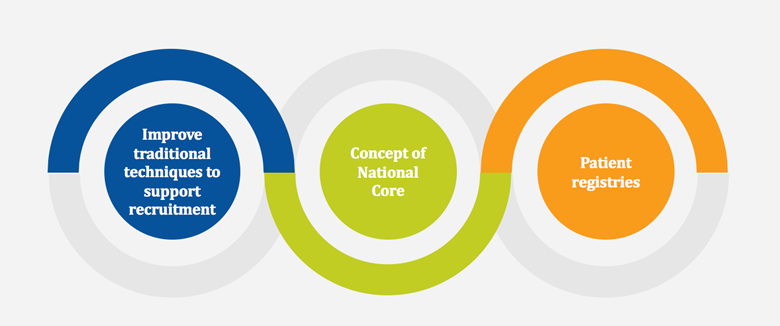Since the mid-1990s, researchers have struggled to enroll sufficient numbers of patients in their trials for Alzheimer’s disease (AD) therapies. As a result, few new therapies have actually come to market—which is tragic for the 47 million people currently living with the disease.
Three key strategies, executed in concert, may help overcome recruitment issues in the short-term, while deepening the pipeline for the future.

1. Improve traditional techniques of supporting recruitment.
There are many barriers to traditional recruitment, including a high screen-failure rate and poorly designed trials. Yet, there remain two key barriers to traditional enrollment—fortunately, there are several potential solutions to each:
Primary care physicians don’t have the capacity or resources to assess cognition and refer patients to research.
- Appeal to current trial participants to join new trials. Current participants have already demonstrated both eligibility and the motivation to participate; many are eager to enroll in subsequent studies once their current trial is complete or has stopped.
- Increase referrals from memory clinics. The ideal trial site has a high concentration of diagnosed AD patients. The ever-increasing number of memory clinics operating across the United States, most unaffiliated with medical schools or universities, provide fertile grounds for recruitment.
- Launch a nationwide media campaign to increase public awareness. Local and national advertisements across print and electronic media can increase public awareness about the critical need for volunteers as trial participants—including healthy individuals who can be studied to assess preventative measures.
- Harness direct mail recruitment. Extensive use of mailing lists can identify new volunteers through wide distribution of recruitment materials.
Study designs often lack cultural sensitivity, which can create barriers to participation for underrepresented communities.
- Partner with community organizations. Providing lectures, seminars and other forms of community education can help increase understanding of the disease and of the need for and mechanics of clinical trials.
- Consider target populations when designing study mechanisms. Most Asian populations, for instance, have a cultural aversion to invasive procedures such as lumbar punctures and brain imaging with an injected tracer agent. Only trials with noninvasive measurement techniques will experience successful recruitment within these populations.
2. Explore the concept of a National Core.
In 2016, a group of key stakeholders from academia, industry, government and the nonprofit sectors met in Toronto, Canada to discuss enrollment challenges in AD studies. One of the long-term solutions that the group proposed was a national core: a multi-user resource to help clinical trials and longitudinal observational studies seeking to recruit participants. The National Health Institute and others have included this concept as an integral part of several funding mechanisms, and it has been used as a standalone research resource for collecting, banking and distributing cell tissues and other bio fluids. This model of shared resources bears further exploration, as it could alleviate much of the burden of recruitment in clinical trials.
3. Implement national patient registries.
Just as an integrated standing network of clinical trial sites can increase the efficiency of trial execution, local disease registries and trial-ready cohorts can speed recruitment. Patients enrolled in such registries have already expressed a willingness to participate in research; they even may have defined the types of studies they are or are not interested in—and they certainly can be quickly contacted upon IRB approval of a new protocol.
Current national registry models have a variety of strengths, including the potential for greater publicity through national campaigns. Registries currently in place include:
- The Alzheimer’s Association Trial Match. A service that generates customized lists of clinical studies for which patients may qualify based on the information they provide.
- The Alzheimer’s Prevention Registry. A registry that connects scientists with healthy volunteers interested in taking part in prevention studies.
- The Dominantly Inherited Alzheimer Network Trials Unit (DIAN-TU) Expanded Registry. A registry designed to aid recruitment of individuals at risk of having a gene mutation that causes dominantly inherited AD to trials of potential DMTs
- The Brain Health Registry. A global online registry for anyone age 18 years and older interested in research for new treatments for AD and other conditions that affect brain function (includes opportunities for clinical trial participation)
- The Global Alzheimer’s Platform (GAP) initiative. An initiative to build large well-characterized trial-ready cohorts to achieve greater uniformity in trial populations as one leg of reducing clinical testing cycle time.
- The Alzheimer’s Disease Cooperative Study (ADCS). A federal-university collaboration that is part of the Alzheimer Prevention Initiative
- The Join Dementia Research initiative. A registry in the United Kingdom created by the National Institute for Health Research, Alzheimer Scotland, Alzheimer’s Research UK and Alzheimer’s Society for people to express interest in Alzheimer’s research and be matched to suitable studies.
There are many techniques and tools that researchers can successfully implement to boost enrollment in AD trials. Some will prove more powerful than others and not all will work in every country. Yet the urgency of the problem demands that we band together, pushing in every direction to discover the means to treat and tame this dreaded disease.
